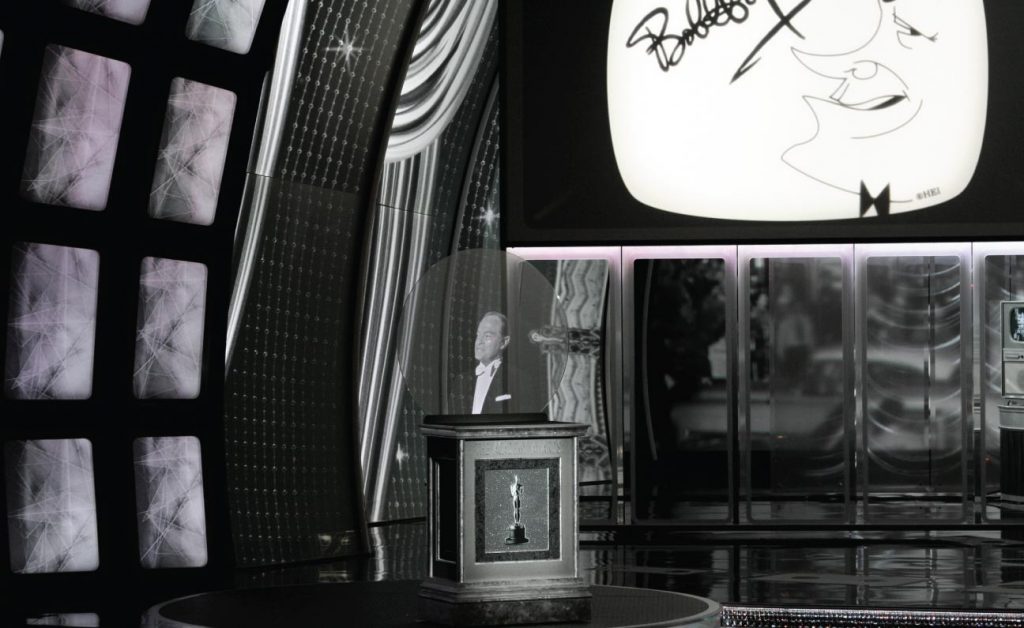Posted March 8th, 2021 by Emily Burkinshaw & filed under , General, How To's, Technology.
Despite its futuristic appearance, holographic projection has been around since the 1940s—the term “hologram” was actually first coined by Hungarian/British engineer Dennis Gabor back in 1949. Holographic projectors essentially provide either a two-dimensional or three-dimensional projection which can be seen without any additional equipment (such as cameras or glasses).
Used well, holographic projection technology can provide a stunning visual experience—whether it’s simple ‘Pepper’s Ghost’ style effects, the late Bob Hope re-appearing at the 83rd Oscar’s, or Halsey performing ‘Without Me’ underwater at the 2018 MTV EMAs.
Let’s explore what holographic projection is, how holographic screens work, and where they can be put to use for the greatest possible effects.
How Holographic Screens Work
Creating a hologram effect on a large scale can not only be an incredibly costly undertaking, it can also require a huge amount of space to work effectively. Alternatively, pairing a holographic screen with a standard projector is a great way to create a holographic effect without the hefty price tag.
There are two main types of holographic projection screen: front and rear. Let’s explore how both of these work in more detail.
Rear Projection Holographic Screen
Our Clearview Rear Projection Holographic Screen is manufactured as a self-adhesive film or acrylic screen and produces a sharp ‘peppers ghost’ visual image. This holographic effect screen creates a 2D image or a ‘false hologram’ visual effect and is frequently used in museums, live events, and product launches. Whilst it doesn’t provide a 3D image, this option takes up minimal floor space and allows for the projector to be placed behind the screen, meaning that it will be out of sight at all times.
With such a minimal space necessary to use these projection screens and the benefit of their transparent composition, you can produce an image that appears to be floating in mid-air, creating a more realistic hologram effect than a standard projection screen.
Our Rear Projection Holographic Screens are also favoured by the silver screen as a more realistic alternative to CGI technology. We’ve seen our Clearview Film used to create a realistic spaceship set in Guardians of the Galaxy Vol.2 (Marvel Studios, 2017) and hologram imagery in Transcendence (Warner Bros, 2013), both creating a more believable effect than its computer-generated counterpart.
Front Projection Holographic Screen
Our Clearvision Holographic Screen, a new UST Front Projection Holographic Effect Screen, is also manufactured as a self-adhesive film or glass screen, ideal for creating visual effects and creating a peppers ghost style effect on both sides of the screen. Like our Clearview Screen these front projection screens produce a 2D holographic effect image, however, our Clearvision screens also produce a dual image, displaying content on both sides of the screen.
This screen delivers a classic ‘Pepper’s Ghost’ effect, also commonly known as ‘faux-lography’, where a ‘false hologram’ is displayed onto a semi-transparent projection screen for maximal effect. One of the main benefits of using a UST Front Projection Holographic Effect Screen is that you can position the projector very close to the screen (depending on the screen size) allowing for more freedom of movement around your display.
This semi transparent screen is ideal for creating a holographic effect image in applications that cannot accommodate rear projection or don’t have the budget for larger scale holographic projection systems.
The Benefits of Holographic Projection Screens
There are multiple benefits to holographic effect projection screens. First, it gives you the ability to create an image as close to 3D projections as possible without the price tag whilst still making for a truly unforgettable visual experience. Our holographic effect projection screens give new purpose to standard projectors, which could previously never compete with the lucrative 3D hologram technology on the specialist market.
In addition to this, holographic projectors are usually only one piece of the puzzle when it comes to creating a convincing holographic image. The full set up needed to pull off the likes of a life size hologram often requires the use of multiple projectors and glass screens, and in some cases needs the likes of bulky, unappealing housing in order to work. Our holographic screen solutions champion the simplicity of their setup and usage, working simply with the use of a standard projector to create a superior visual effect.
Whilst our holographic screens might not create a 3D image, the immersive 4K ‘peppers ghost’ effect they do produce is enough to eradicate novelty of wearing 3D glasses forever!
Holographic Projection in Action
Okay, this all sounds great—but what does holographic projection actually look like in action?
You may remember Halsey’s performance at the 2018 MTV EMAs, which used Pro Display’s Clearview Holographic Effect Rear Projection Technology to make it appear as though Halsey was performing in an underwater box. Clearview technology allowed the box to go from clear to producing an underwater effect in an instant, with real water falling as rain to add to the effect. This enabled Halsey to splash around within the box as she performed.
And then there was the 83rd Annual Academy Awards (Oscars) in 2011, where Pro Display’s Clearview technology brought Bob Hope back to life so that he could ‘re’-deliver his speech from the first televised Oscars back in 1953. Not only did we ‘resurrect’ a Hollywood legend, we also provided 38 additional Clearview screens which forged the foundations of the stage design for the show itself. The incredible stage performance earned a well deserved Emmy nomination for producers Bruce Cohen and Don Mischer, and even earned us a win for ‘Live Event of the Year’ at the AV Awards that year!

